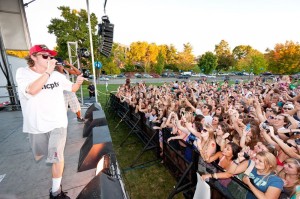By Jessica Rafalko
Writer
At Saturday’s Fall Fest, a woman approached me after Na Palm’s opening performance to ask what paper I wrote for. Looking official, press tag and all, I held up my consummate notepad and told her I was writing for the school paper. She then told me with obvious distaste that it was a waste of money for the University to bring in performers like Na Palm: guys who asked the crowd if they liked to party, if they liked to smoke. The woman then pointed to the students surging toward the stage and said, “And they’re just stupid enough to buy into it.”
I shook my head, as if to say, “I know what you mean.”
But my indignation was mostly for show. It’s true that Na Palm, G. Curtis and Sam Adams incorporate that unholy trinity of sex, drugs and rock ‘n’ roll into their acts, but the content of their acts shouldn’t bar them from performing on our campus—especially when their music in many ways offers an accurate portrayal of certain aspects of college life.
I think the outraged woman was responding less to the content of the music and more to the students’ reaction to it. By accepting Na Palm’s suggestion that all they do is party–drink, smoke, get laid—with enthusiasm of the hoot-and-holler variety, students confirmed all those awful but knowing suspicions society has about life on a college campus.
College students are seen as self-indulgent, irresponsible and reckless. This university, like most with rural campuses, has a reputation as a party school. Beer pong may or may not have originated here. We have an active Greek life, which makes the “Animal House” comparisons unavoidable. When I first visited this campus as a high school senior, it reminded me of the colleges you see on TV and in movies. We ooze that distinctly collegiate blend of quality academia and killer parties.
So what right do people have to be offended when musicians point out the obvious? We’re not naïve enough to think these things don’t happen on campus. There is alcohol; there is pot; there is, of course, sex. Sam Adams and company weren’t wrong in assuming we like to party—really, they were just stating the obvious.
It’s hard to determine where the problem lies. Are students at fault for partying? Is the University at fault for inviting certain performers to campus? Or is society at fault for simultaneously condoning and denying what goes on in college?
Before I left for school, my parents told me, “Look, we know you’re going to drink. It’s college.” Still, if I called them one night and said, “Hey, guess what? You were right about that drinking thing,” chances are they would respond with heavy sighs and veiled disappointment. Society employs a reverse psychology; it’s as if acknowledging the partying that goes on in college will render it a non-threat.
“Don’t party,” they tell us, but at the same time they say, “Partying is a part of college.”
If you want to believe Sam Adams’s music is a threat to society’s sensibilities, that’s your prerogative. But then how can you justify perpetuating an equally damaging mixed message?


